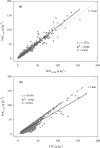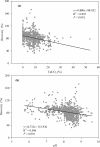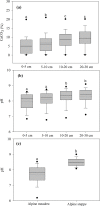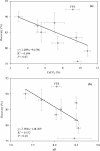A comparison of two methods for quantifying soil organic carbon of alpine grasslands on the Tibetan Plateau
- PMID: 25946085
- PMCID: PMC4422439
- DOI: 10.1371/journal.pone.0126372
A comparison of two methods for quantifying soil organic carbon of alpine grasslands on the Tibetan Plateau
Abstract
As CO2 concentrations continue to rise and drive global climate change, much effort has been put into estimating soil carbon (C) stocks and dynamics over time. However, the inconsistent methods employed by researchers hamper the comparability of such works, creating a pressing need to standardize the methods for soil organic C (SOC) quantification by the various methods. Here, we collected 712 soil samples from 36 sites of alpine grasslands on the Tibetan Plateau covering different soil depths and vegetation and soil types. We used an elemental analyzer for soil total C (STC) and an inorganic carbon analyzer for soil inorganic C (SIC), and then defined the difference between STC and SIC as SOCCNS. In addition, we employed the modified Walkley-Black (MWB) method, hereafter SOCMWB. Our results showed that there was a strong correlation between SOCCNS and SOCMWB across the data set, given the application of a correction factor of 1.103. Soil depth and soil type significantly influenced on the recovery, defined as the ratio of SOCMWB to SOCCNS, and the recovery was closely associated with soil carbonate content and pH value as well. The differences of recovery between alpine meadow and steppe were largely driven by soil pH. In addition, statistically, a relatively strong correlation between SOCCNS and STC was also found, suggesting that it is feasible to estimate SOCCNS stocks through the STC data across the Tibetan grasslands. Therefore, our results suggest that in order to accurately estimate the absolute SOC stocks and its change in the Tibetan alpine grasslands, adequate correction of the modified WB measurements is essential with correct consideration of the effects of soil types, vegetation, soil pH and soil depth.
Conflict of interest statement
Figures






References
-
- Luo YQ. Terrestrial carbon-cycle feedback to climate warming. Annu Rev Ecol Evol S. 2007;38:683–712.
-
- Davidson EA, Janssens IA. Temperature sensitivity of soil carbon decomposition and feedbacks to climate change. Nature. 2006;440:165–173. - PubMed
-
- Kutsch W, Bahn M, Heinemeyer A. Soil carbon dynamics: an integrated methodology: Cambridge University Press; 2009.
Publication types
MeSH terms
Substances
LinkOut - more resources
Full Text Sources
Other Literature Sources
Research Materials

